Mineralogical Insights into PGM Recovery from Middle Group (1–4) Chromite Tailings
Abstract
:1. Introduction
2. Materials and Methods
2.1. Sample Preparation
2.2. Bulk Chemistry and Modal Mineralogy
2.3. PGMs Characteristics
3. Results
3.1. Particle Size Distribution (PSD) of the Chromite Tailings
3.2. Bulk Chemical Composition of Chromite Tailings
3.3. Bulk Chemistry and Modal Mineralogy of Chromite Tailing
3.4. Characterisation of PGM Species Found in the MG 1–4 Chromite Tailings
3.4.1. PGM Species of the MG 1–4 Chromite Tailings
3.4.2. Liberated PGMs Grain Size Distribution in the Chromite Tailings
3.4.3. PGMs Mineral Mode of Occurrence in the MG 1–4 Chromite Tailings
3.4.4. Liberation Index of the PGM in the Chromite Tailings
3.4.5. PGM Grain Distributions in Different Size Fractions of the Chromite Tailings
3.4.6. PGMs–BMS–Gangue Associations in the MG 1–4 Chromite Tailings
4. Conclusions
Author Contributions
Funding
Data Availability Statement
Acknowledgments
Conflicts of Interest
References
- Yudovskaya, M.A.; Kinnaird, J.A. Chromite in the Platreef (Bushveld Complex, South Africa): Occurrence and evolution of its chemical composition. Miner. Depos. 2010, 45, 369–391. [Google Scholar] [CrossRef]
- Junge, M.; Oberthür, T.; Osbahr, I.; Gutter, P. Platinum-group elements and minerals in the lower and middle group chromitites of the western Bushveld Complex, South Africa. Miner. Depos. 2016, 51, 841–852. [Google Scholar] [CrossRef]
- Oberthür, T.; Junge, M.; Rudashevsky, N.; de Meyer, E.; Gutter, P. Platinum-group minerals in the LG and MG chromitites of the eastern Bushveld Complex, South Africa. Miner. Depos. 2016, 51, 71–87. [Google Scholar] [CrossRef]
- Langa, M.M.; Jugo, P.J.; Leybourne, M.I.; Grobler, D.F.; Adetunji, J.; Skogby, H. Chromite chemistry of a massive chromitite seam in the northern limb of the Bushveld Igneous Complex, South Africa: Correlation with the UG-2 in the eastern and western limbs and evidence of variable assimilation of footwall rocks. Miner. Depos. 2021, 56, 31–44. [Google Scholar] [CrossRef]
- Sefako, R.; Sekgarametso, K.; Sibanda, V. Potential Processing Routes for Recovery of Platinum Group Metals from Southern African Oxidized PGM Ores: A Review. J. Sustain. Metall. 2017, 3, 797–807. [Google Scholar] [CrossRef]
- Corin, K.C.; McFadzean, B.J.; Shackleton, N.J.; O’connor, C.T. Challenges related to the processing of fines in the recovery of platinum group minerals (PGMs). Minerals 2021, 11, 533. [Google Scholar] [CrossRef]
- Murthy, Y.R.; Tripathy, S.K.; Kumar, C.R. Chrome ore beneficiation challenges & opportunities—A review. Miner. Eng. 2011, 24, 375–380. [Google Scholar] [CrossRef]
- Ghorbani, Y.; Zhang, S.E.; Nwaila, G.T.; Bourdeau, J.E.; Safari, M.; Hoseinie, S.H.; Nwaila, P.; Ruuska, J. Dry laboratories—Mapping the required instrumentation and infrastructure for online monitoring, analysis, and characterization in the mineral industry. Miner. Eng. 2023, 191, 107971. [Google Scholar] [CrossRef]
- Cawthorn, R.G.; Cawthorn, R.G. Geological interpretations from the PGE distribution in the Bushveld Merensky and UG2 chromitite reefs. J. S. Afr. Inst. Min. Metall. 2017, 111, 11–14. [Google Scholar]
- Cawthorn, R.G. The platinum and palladium resources of the Bushveld Complex. S. Afr. J. Sci. 1999, 95, 481–489. [Google Scholar]
- Kottke-Levin, J. A Geochemical Study of the Middle Group Chromitites, Helena Mine, Bushveld Complex, South Africa. Ph.D. Thesis, University of the Free State, Bloemfontein, South Africa, 2011. [Google Scholar]
- Bachmann, K.; Menzel, P.; Tolosana-Delgado, R.; Schmidt, C.; Hill, M.; Gutzmer, J. Multivariate geochemical classification of chromitite layers in the Bushveld Complex, South Africa. Appl. Geochem. 2019, 103, 106–117. [Google Scholar] [CrossRef]
- Magson, J.; Tredoux, M.; Roelofse, F. Association of platinum-group elements with chromitite within the Merensky reef, Western Limb, Bushveld Complex: Results of a high resolution mineralogical and geochemical study. J. Afr. Earth Sci. 2018, 144, 161–175. [Google Scholar] [CrossRef]
- Maier, W.D.; Bowen, M.P. The UG2—Merensky Reef interval of the Bushveld Complex northwest of Pretoria. Miner. Depos. 1996, 31, 386–393. [Google Scholar] [CrossRef]
- Von Gruenewaldt, G.; Hatton, C.J. Platinum-Group Metals—A Resource in the Tailings of Chromium Mines in South Africa. J. S. Afr. Inst. Min. Metall. 1987, 87, 265–268. [Google Scholar]
- Hoeve, T.J.V.; Scoates, J.S.; Wall, C.J.; Weis, D.; Amini, M. A temperature-composition framework for crystallisation of fractionated interstitial melt in the Bushveld Complex from trace element systematics of sircon and rutile. J. Petrol. 2018, 59, 1383–1416. [Google Scholar] [CrossRef]
- Scoon, R.N.; Viljoen, M.J. Geoheritage of the Eastern Limb of the Bushveld Igneous Complex, South Africa: A Uniquely Exposed Layered Igneous Intrusion. Geoheritage 2019, 11, 1723–1748. [Google Scholar] [CrossRef]
- McIntosh, R. Petrogenesis of the LG-6 Chromitite at Ruighoek Mine Western Limb of the Bushveld Complex. Ph.D. Thesis, University of the Witwatersrand, Johannesburg, South Africa, 2017. [Google Scholar]
- Langa, M.M.; Jugo, P.J.; Leybourne, M.I.; Grobler, D.F. Stratigraphic variations in chromite chemistry through the UG-2 and UG-2E chromitites, bushveld igneous complex: Implications for chromitite petrogenesis. Int. Geol. Rev. 2023, 65, 2961–2979. [Google Scholar] [CrossRef]
- Cawthorn, R.G.; Lee, C.A.; Schouwstra, R.P.; Mellowship, P. Relationship between PGE and PGM in the bushveld complex. Can. Miner. 2002, 40, 311–328. [Google Scholar] [CrossRef]
- Meima, J.A.; Rammlmair, D.; Junge, M. The use of Laser Induced Breakdown Spectroscopy for the mineral chemistry of chromite, orthopyroxene and plagioclase from Merensky Reef and UG-2 chromitite, Bushveld Complex, South Africa. Chem. Geol. 2021, 589, 120686. [Google Scholar] [CrossRef]
- Chetty, D.; Gryffenberg, L.; Lekgetho, T.B.; Molebale, I.J. Automated SEM study of PGM distribution across a UG2 flotation concentrate bank: Implications for understanding PGM floatability. J. S. Afr. Inst. Min. Metall. 2009, 109, 587–593. [Google Scholar]
- Gibson, B.A.; Nwaila, G.; Manzi, M.; Ghorbani, Y.; Ndlovu, S.; Petersen, J. The valorisation of platinum group metals from flotation tailings: A review of challenges and opportunities. Miner. Eng. 2023, 201, 108216. [Google Scholar] [CrossRef]
- Penberthy, C.J. The Effect of Mineralogical Variation in the UG2 Chromitite on Recovery of Platinum-Group Elements. Ph.D. Thesis, University of Pretoria, Pretoria, South Africa, 2006. [Google Scholar]
- Naldrett, A.J.; Wilson, A.; Kinnaird, J.; Yudovskaya, M.; Chunnett, G. The origin of chromitites and related PGE mineralization in the Bushveld Complex: New mineralogical and petrological constraints. Miner. Depos. 2011, 47, 209–232. [Google Scholar] [CrossRef]
- Safari, M.; Harris, M.; Deglon, D. The effect of energy input on the flotation of a platinum ore in a pilot-scale oscillating grid flotation cell. Miner. Eng. 2017, 110, 69–74. [Google Scholar] [CrossRef]
- Ramonotsi, M. Characterisation of the Effect of Alteration on the PPM Platinum Ore and Evaluation of Selected Strategies to Improve Metallurgical Performance. Master’s Thesis, University of Cape Town, Cape Town, South Africa, 2011. [Google Scholar]
- Carelse, C.; Manuel, M.; Chetty, D.; Taguta, J.; Safari, M.; Youlton, K. The flotation behaviour of liberated Platinum Group minerals in Platreef ore under reduced reagent conditions. Miner. Eng. 2022, 190, 107913. [Google Scholar] [CrossRef]
- Sibanda, V.; Khan, R.; Danha, G. The effect of chemical reagents on flotation performance of a pentlandite ore: An attainable region approach. Powder Technol. 2019, 352, 462–469. [Google Scholar] [CrossRef]
- Safari, M.; Hoseinian, F.; Deglon, D.; Filho, L.L.; Pinto, T.S. Impact of flotation operational parameters on the optimization of fine and coarse Itabirite iron ore beneficiation. Powder Technol. 2022, 408, 117772. [Google Scholar] [CrossRef]
- Graham, S.D.; Brough, C.P.; Cropp, A. An introduction to SEISS Mineralogic Mining and the correlation of light mi-croscopy with automated mineralogy: A case study using BMS and PGM analysis of samples from a PGE-bearing chromitite prospect. Precious Metall. 2015, 15, 10. [Google Scholar]
- Bradshaw, D. The role of ‘process mineralogy’ in improving the process performance of complex sulphide ores. In Proceedings of the IMPC 2014—27th International Mineral Processing Congress, Santiago, Chile, 20–24 October 2014. [Google Scholar]
- Bulatovic, S. Evaluation of alternative reagent schemes for the flotation of platinum group minerals from various ores. Miner. Eng. 2003, 16, 931–939. [Google Scholar] [CrossRef]
- Jameson, G.J. The effect of surface liberation and particle size on flotation rate constants. Miner. Eng. 2012, 36–38, 132–137. [Google Scholar] [CrossRef]
- Safari, M.; Hoseinian, F.S.; Deglon, D.; Filho, L.L.; Souza, T.C. Investigation of the reverse flotation of hematite in three different types of laboratory flotation cells. In Proceedings of the XXIX International Mineral Processing Congress 2019 (IMPC 2018), Moscow, Russia, 17–21 September 2018; pp. 1376–1383. [Google Scholar]
- Hoseinian, F.S.; Bahram, R.; Elaheh, K.; Mehdi, S. The effect of water recovery on the ion flotation process efficiency. Physicochem. Probl. Miner. Process. 2020, 56, 919–927. [Google Scholar] [CrossRef]
- Sajjad, M.; Otsuki, A. Correlation between Flotation and Rheology of Fine Particle Suspensions. Metals 2022, 12, 270. [Google Scholar] [CrossRef]
- Safari, M.; Deglon, D. An Attachment-Detachment Kinetic Model for the Effect of Energy Input on Flotation. Miner. Eng. 2018, 117, 8–13. [Google Scholar] [CrossRef]
- Pease, J.D.; Young, M.F.; Curry, D.; Johnson, N.W. Improving fines recovery by grinding finer. Miner. Process. Extr. Metall. 2010, 119, 216–222. [Google Scholar] [CrossRef]
- Tsave, P.K.; Kostoglou, M.; Karapantsios, T.D.; Lazaridis, N.K. A hybrid device for enhancing flotation of fine particles by combining micro-bubbles with conventional bubbles. Minerals 2021, 11, 561. [Google Scholar] [CrossRef]
- Sadovskiy, D.; Rulyova, N.; Filippov, L. Column flotation of fine glass beads enhanced by their prior heteroaggregation with microbubbles. Colloids Surf. A Physicochem. Eng. Asp. 2021, 617, 126398. [Google Scholar] [CrossRef]
- Hassanzadeh, A.; Safari, M.; Khoshdast, H.; Güner, M.K.; Hoang, D.H.; Sambrook, T.; Kowalczuk, P.B. Introducing key advantages of intensified flotation cells over conventionally used mechanical and column cells. Physicochem. Probl. Miner. Process. 2022, 58, 155101. [Google Scholar] [CrossRef]
- Hassanzadeh, A.; Safari, M.; Hoang, D.H.; Khoshdast, H.; Albijanic, B.; Kowalczuk, P.B. Technological assessments on recent developments in fine and coarse particle flotation systems. Miner. Eng. 2022, 180, 107509. [Google Scholar] [CrossRef]
- Sefako, R.; Sibanda, V.; Sekgarametso, K. PGM extraction from oxidized ores using flotation and leaching. J. S. Afr. Inst. Min. Metall. 2019, 119, 929–936. [Google Scholar] [CrossRef]
- Soufiabadi, A.M.; Dehghan, R.; Nejadaria, M.; Safari, M.; Hassanzadeh, A.; Khoshdast, H. Effect of different process water sources on rougher flotation efficiency of a copper ore: A case study at Sarcheshmeh Copper Complex (Iran). Physicochem. Probl. Miner. Process. 2023, 59, 184087. [Google Scholar] [CrossRef]
- Murthy, Y.R.; Tripathy, S. Process optimization of a chrome ore gravity concentration plant for sustainable development. J. S. Afr. Inst. Min. Metall. 2020, 120, 26–268. [Google Scholar] [CrossRef]
- Pease, J.; Curry, D.; Young, M. Designing flotation circuits for high fines recovery. Miner. Eng. 2005, 19, 831–840. [Google Scholar] [CrossRef]
- Malenga, E.N.; Mulaba-Bafubiandi, A.; Nheta, W. Application of the response surface method (RSM) based on central composite design (CCD) and design space (DS) to optimize the flotation and the desliming conditions in the recovery of PGMs from mine sludge. Sep. Sci. Technol. 2022, 57, 2960–2983. [Google Scholar] [CrossRef]
- Singh, A. Enhanced flotation of platinum mineral fines through feed cavitation: ‘Bringing the mountain to Mohamed’. In Proceedings of the IMPC 2016: XXVIII International Mineral Processing Congress Proceedings, Quebec City, QC, Canada, 11–15 September 2016; Canadian Institute of Mining, Metallurgy and Petroleum: Montreal, QC, Canada, 2016. [Google Scholar]
- Baloyi, N.; Nheta, W.; Sibanda, V. Characterisation of PGMs-Bearing Chromite Plant Tailings. In Proceedings of the 39th JOHANNESBURG International Conference on “Chemical, Biological and Environmental Engineering” (JCBEE-23), Johannesburg, South Africa, 16–17 November 2023. [Google Scholar] [CrossRef]
- Amaral, L.F.S. The Distribution of Platinum-Group Elements and Other Chalcophile Elements among Sulfide Minerals from the Ovoid Ore Body of the Voisey’s Bay Ni-Cu Sulfide Deposit. Ph.D. Thesis, Université du Québec à Chicoutimi, Chicoutimi, QC, Canada, 2017. [Google Scholar]
- Edwards, R. Ore Deposit Geology and Its Influence on Mineral Exploration; Springer Science & Business Media: Berlin/Heidelberg, Germany, 2012. [Google Scholar]
- Nazari, S.; Hoseinian, F.S.; Li, J.; Safari, M.; Khoshdast, H.; Li, J.; He, Y. Synergistic effect of grinding time and submicron (nano) bubbles on the zeta potential state of spent lithium-ion batteries: A gene expression programming approach. J. Energy Storage 2023, 70, 107942. [Google Scholar] [CrossRef]
- Martinovic, J.; Bradshaw, D.J.; Harris, P.J. Investigation of surface properties of gangue minerals in platinum bearing ores. J. S. Afr. Inst. Min. Metall. 2005, 105, 349–356. [Google Scholar]
- Shackleton, N.; Malysiak, V.; O’connor, C. Surface characteristics and flotation behaviour of platinum and palladium tellurides. Miner. Eng. 2007, 20, 1232–1245. [Google Scholar] [CrossRef]
- Nel, E.; Martin, C. Ore Processing at Impala’s UG-2 concentrator in Rustenburg, South Africa. Tech-Bull 2004, 2. [Google Scholar]
- Taguta, J.; Safari, M.; Govender, V.; Chetty, D. Investigating the Amenability of a PGM-Bearing Ore to Coarse Particle Flotation. Minerals 2023, 13, 698. [Google Scholar] [CrossRef]
- Safari, M.; Hoseinian, F.; Deglon, D.; Filho, L.L.; Pinto, T.S. Investigation of the reverse flotation of iron ore in three different flotation cells: Mechanical, oscillating grid and pneumatic. Miner. Eng. 2020, 150, 106283. [Google Scholar] [CrossRef]
- Safari, M.; Deglon, D. Evaluation of an Attachment–Detachment Kinetic Model for Flotation. Minerals 2020, 10, 978. [Google Scholar] [CrossRef]
- Junge, M.; Oberthür, T.; Kraemer, D.; Melcher, F.; Piña, R.; Derrey, I.T.; Manyeruke, T.; Strauss, H. Distribution of platinum-group elements in pristine and near-surface oxidized Platreef ore and the variation along strike, northern Bushveld Complex, South Africa. Miner. Depos. 2019, 54, 885–912. [Google Scholar] [CrossRef]
- Hoseinian, F.S.; Safari, M.; Deglon, D. Ion flotation kinetic predictions using empirical and phenomenological models. Miner. Eng. 2024, 210, 108645. [Google Scholar] [CrossRef]
- Anzoom, S.J.; Bournival, G.; Ata, S. Coarse particle flotation: A review. Miner. Eng. 2024, 206, 108499. [Google Scholar] [CrossRef]
- Mailula, T.D.; Bradshaw, D.J.; Harris, P.J. The effect of copper sulphate addition on the recovery of chromite. J. S. Afr. Inst. Min. Metall. 2003, 103, 143–146. [Google Scholar]
- Pownceby, M.I.; McCallum, D.A.; Bruckard, W.J. Automated and Quantitative Mineralogy Applied to Chromite Ore Characterization and Beneficiation. Minerals 2023, 13, 440. [Google Scholar] [CrossRef]
- McCallum, D.A.; Bruckard, W.J.; Pownceby, M.I. Chromite ore—Characterisation through to processing. In Proceedings of the MetPlant 2008, Perth, Australia, 18–19 August 2008. [Google Scholar]
- Mokadze, A.M.; Ndlovu, S.; Shemi, A.; Dworzanowski, M. The Reduction of Chrome in UG-2 Flotation Concentrate by Hydrometallurgical Means. Int. J. Miner. Process. Extr. Metall. 2021, 6, 41. [Google Scholar] [CrossRef]
- Ramlall, N. Measuring and modelling entrainment in rougher and cleaner batch flotation. J. S. Afr. Inst. Min. Metall. 2020, 120, 233–242. [Google Scholar] [CrossRef]
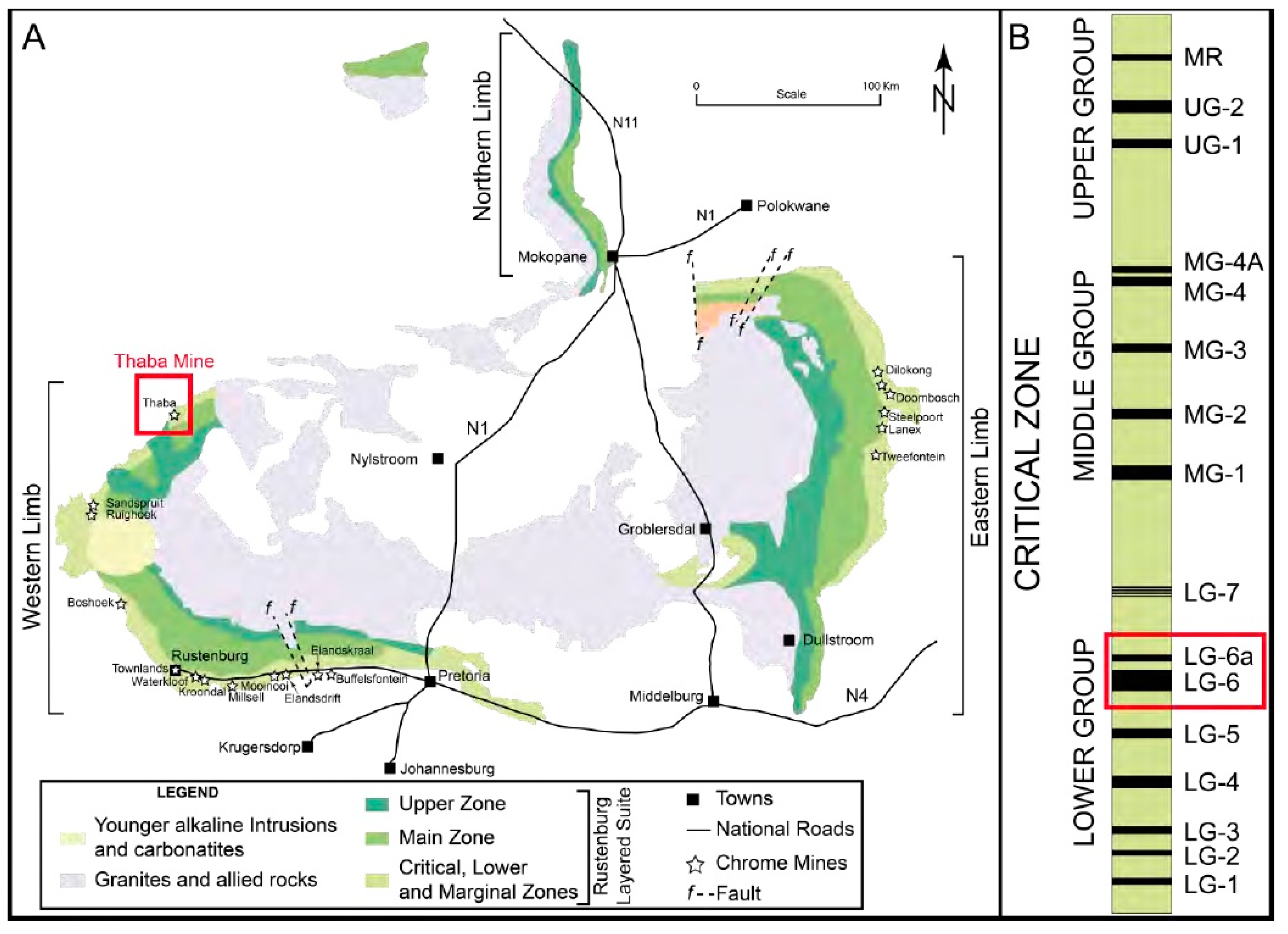
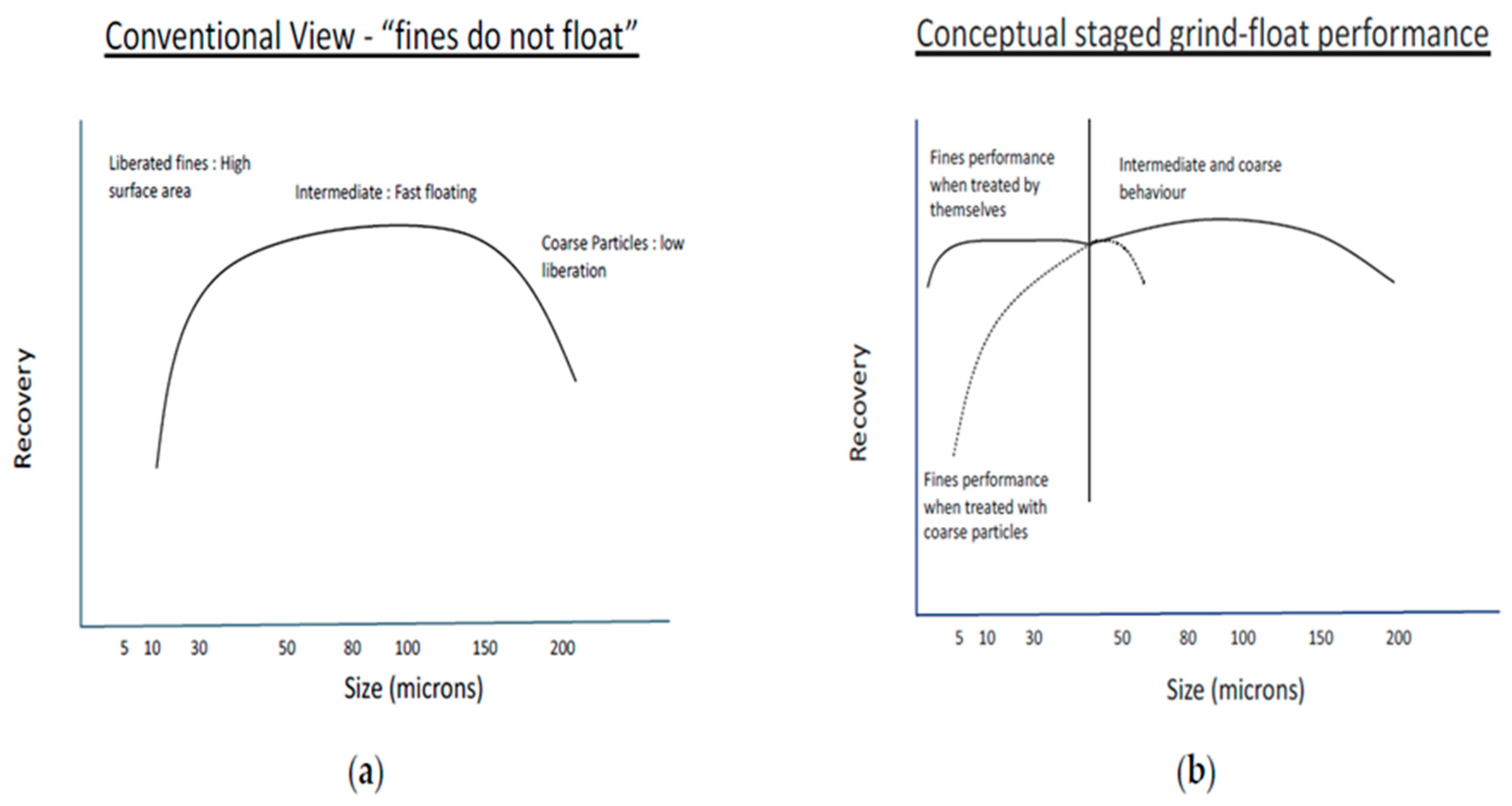
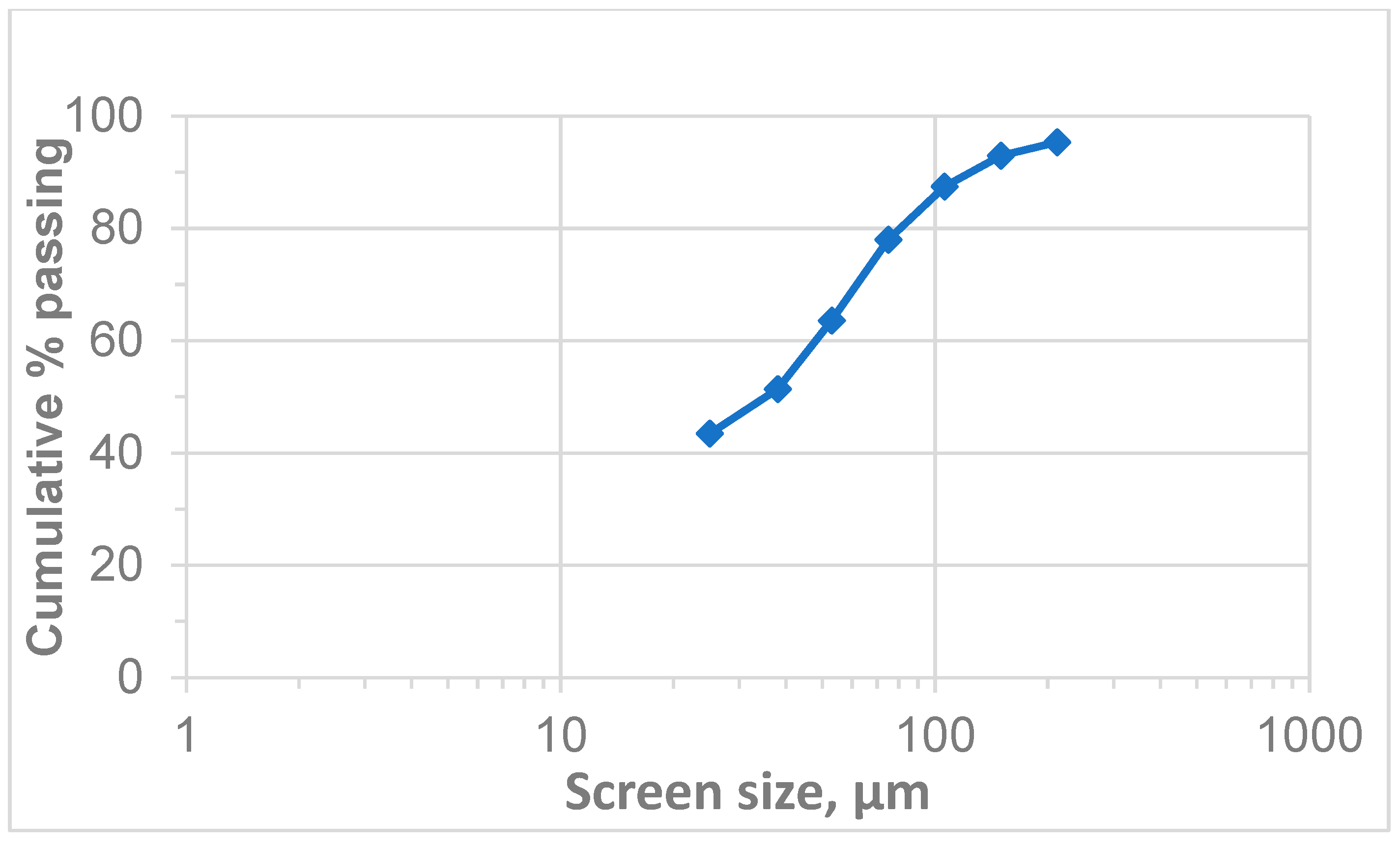
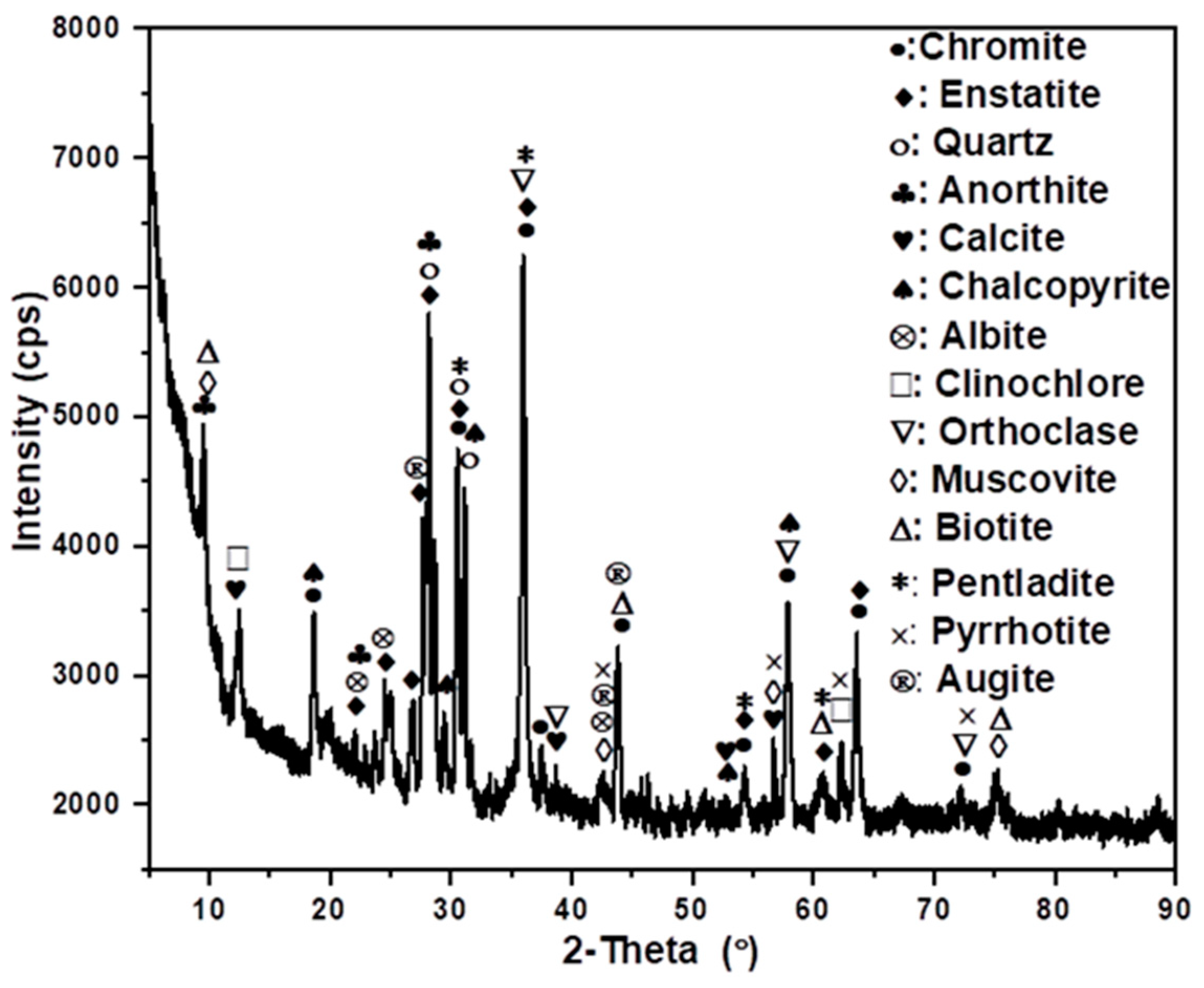

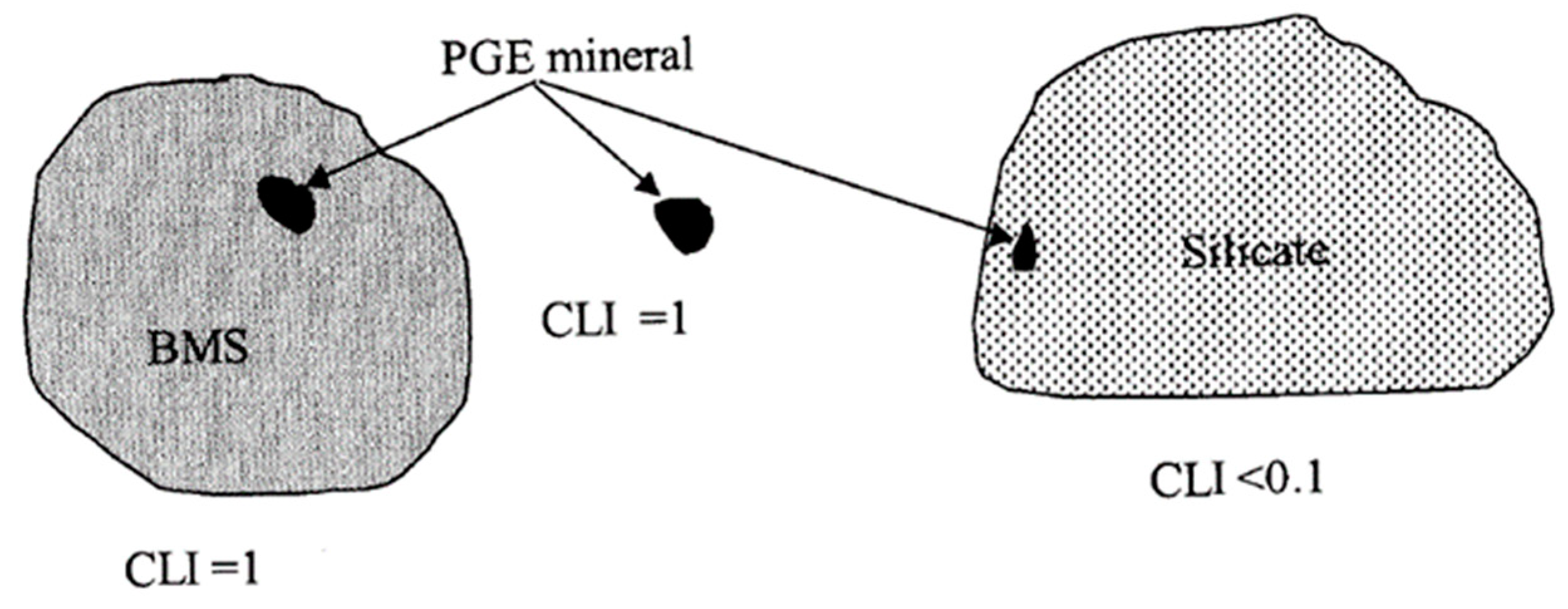
| Class | Minerals | Merensky Reef | UG2 Reef | Plat Reef |
|---|---|---|---|---|
| Volume % | ||||
| PGM Alloys | Ferroplatinum | 40 | 40 | 11–30 |
| Pt Alloy | ||||
| Pd Alloy | ||||
| Electrum (Au) | 2 | 0.2 | 3 | |
| Arsenides | Pt-arsenides | 4 | 0.1–1 | 1–20 |
| Pd-arsenides | ||||
| PGE-sulphurarsenides | 3 | 0.8–7 | 16–35 | |
| PGM sulphides | PtPd-sulphide | 16 | 40–60 | 1–7 |
| Pt-sulphide | ||||
| PtRh-sulphide | ||||
| Tellurides | Pt-tellurides | 35 | 0.5–5 | 20–50 |
| Pd-tellurides | ||||
| Screen Size (µm) | Cumulative % Passing | Cr2O3 (%) | Al2O3 (%) | Fe2O3 (%) | CaO (%) | MgO (%) | SiO2 (%) | Cu (ppm) | Ni (ppm) |
|---|---|---|---|---|---|---|---|---|---|
| −25 | 0.00 | 14.62 | 5.12 | 15.66 | 2.62 | 4.63 | 17.07 | 101 | 921 |
| +25–38 | 43.48 | 17.65 | 4.95 | 15.54 | 3.02 | 3.45 | 14.12 | 61 | 842 |
| +38–53 | 51.38 | 15.35 | 5.16 | 13.91 | 3.25 | 3.90 | 16.66 | 70 | 824 |
| +53–75 | 63.62 | 13.67 | 5.20 | 12.48 | 3.61 | 3.91 | 17.52 | 67 | 776 |
| +75–106 | 78.00 | 10.36 | 6.33 | 10.92 | 4.45 | 4.81 | 21.78 | 61 | 747 |
| +106–150 | 87.45 | 8.95 | 4.53 | 10.39 | 3.71 | 3.52 | 17.07 | 64 | 685 |
| +150–212 | 92.96 | 6.99 | 4.11 | 9.87 | 3.57 | 3.10 | 17.43 | 58 | 670 |
| +212 | 95.36 | 5.56 | 3.95 | 11.08 | 2.47 | 3.22 | 17.76 | 78 | 670 |
| PGMs (g/t) | |||||
|---|---|---|---|---|---|
| Screen Size (µm) | Au (g/t) | Pd (g/t) | Pt (g/t) | Rh (g/t) | 3E PGM+Au |
| Feed | 0.02 | 0.57 | 2.26 | 0.38 | 3.25 |
| −25 | 0.05 | 0.58 | 3.85 | 0.58 | 5.06 |
| +25–38 | 0.03 | 0.40 | 1.30 | 0.24 | 1.97 |
| +38–53 | 0.03 | 0.35 | 1.14 | 0.21 | 1.73 |
| +53–75 | 0.03 | 0.30 | 0.95 | 0.14 | 1.42 |
| +75–106 | 0.04 | 0.36 | 0.97 | 0.12 | 1.49 |
| +106–150 | 0.03 | 0.25 | 0.71 | 0.10 | 1.09 |
| +150–212 | 0.06 | 0.25 | 0.65 | 0.10 | 1.06 |
| +212 | 0.04 | 0.35 | 1.23 | 0.18 | 1.80 |
| Mineral Group | PGM Mineral | PGM Species | % Abundance | Total % Abundance |
|---|---|---|---|---|
| Sulphides | Cooperite | PtS | 14.1 | 63.6 |
| Braggite | (Pt,Pd,Ni)S | 47.9 | ||
| Malanite | Cu(Pt,Rh,Ir)2S4 | 1.6 | ||
| Laurite | Laurite | RuS2 | 17.3 | 17.3 |
| Sulfarsenide | Ruarsite | RuAsS | 4.3 | |
| Hollingworthite | (Rh,Pt,Pd)AsS | 2.9 | 10.4 | |
| Irarsite | (Ir,Ru,Rh,Pt)AsS | 3.3 | ||
| Alloy | Ferroplatinum Plumboplalladinite | PtFe Pd3Pb2 | 3.7 0.4 | 4.1 |
| Bismuth tellurite | Michenerite | PdBiTe | 3.1 | 3.3 |
| Monchenerite | Pt(Te,Bi)2 | 0.2 | ||
| Arsenide | Sperrylite | PtAs2 | 0.5 | 1.3 |
| Stillwaterite | Pd8As3 | 0.7 | ||
| Atheneite | (Pd,Hg)3As | 0.1 |
| Distribution of PGM Types | |||
|---|---|---|---|
| PGMs | PGM Vol % | PGM Grains | Average ECD (µm) |
| (Pt,Pd,Ni)S | 47.9 | 48 | 4.5 |
| RuS2 | 17.3 | 31 | 3.7 |
| RuAsS | 4.3 | 10 | 3.2 |
| (Rh,Pt,Pd)AsS | 2.9 | 1 | 9.3 |
| Pd8As3 | 0.7 | 1 | 4.5 |
| PdBiTe | 3.1 | 5 | 4.2 |
| PtFe | 3.7 | 8 | 3.5 |
| (Pt,Rh,Cu)S | 1.6 | 1 | 7.0 |
| (Ir,Ru,Rh,Pt)AsS | 3.3 | 4 | 4.6 |
| PtS | 14.1 | 5 | 8.2 |
| (Pd,Hg)3As | 0.1 | 1 | 2.0 |
| (Pt(Bi,Te)2 | 0.2 | 1 | 2.6 |
| PtAs2 | 0.5 | 1 | 3.8 |
| Particle Characteristics | PGM Vol % | PGMs | |
|---|---|---|---|
| Fast-floating | Liberated PGMs > 3 µm ECD | 64.2% | 38 |
| Liberated BMS > 10 µm ECD | 0.2% | 1 | |
| Slow-floating 1 | Liberated PGMs < 3 µm ECD | 2.3% | 13 |
| Liberated BMS < 10 µm ECD | |||
| PGMs > 3 µm ECD attached to gangue | 25.3% | 26 | |
| BMS > 10 µm ECD attached to gangue | |||
| Slow-floating 2 | PGMs < 3 µm ECD attached to gangue | 2.0% | 11 |
| BMS < 10 µm ECD attached to gangue | 0.2% | 1 | |
| Non-floating | PGMs and/or BMS locked in gangue | 5.8% | 28 |
| Grain Size Class (µm) | PGM Grains | PGM Vol % |
|---|---|---|
| 0–3 | 49 | 8.5 |
| 3–6 | 46 | 26.4 |
| 6–9 | 14 | 24.7 |
| 9–12 | 5 | 15.9 |
| 12–15 | 3 | 16.1 |
| 15–18 | 1 | 8.3 |
| Liberation Characteristic | PGMs Vol % | # PGM Grains | # PGM Grains <3 µm ECD | |
|---|---|---|---|---|
| L | Liberated PGM | 66.5% | 51 | 13 |
| SL | PGMs associated with liberated BMS (Base Metal Sulphides) | 0.2% | 1 | 1 |
| SG | PGMs associated with BMS locked in silicate or oxide gangue particles | - | - | - |
| AG | PGMs attached to silicate or oxide gangue particles | 27.3% | 37 | 11 |
| SAG | PGMs associated with BMS attached to silicate or oxide gangue particles | 0.2% | 1 | 1 |
| G | PGMs locked within silicate or oxide gangue particles | 5.8% | 28 | 23 |
| Index | PGM Grains | PGM Vol % | Num % |
|---|---|---|---|
| <0.2 | 64 | 30.8 | 54.2 |
| 0.2–0.4 | 1 | 2.0 | 0.8 |
| 0.4–0.6 | 1 | 0.5 | 0.8 |
| 0.6–0.8 | - | - | - |
| 0.8–1.0 | 52 | 66.7 | 44.1 |
| Fine (<20 µm) | Med (20–50 µm) | Coarse (>50 µm) | |
|---|---|---|---|
| PGM distribution | 74% | 18% | 7.53% |
| SL | AG | SAG | SG | G | |
|---|---|---|---|---|---|
| Plagioclase | 8 | 1 | 4 | ||
| Enstatite | 3 | 1 | |||
| Hornblende | 7 | 5 | |||
| Chlorite | 4 | 2 | |||
| Chromite | 10 | 15 | |||
| Magnetite | 1 | ||||
| Rutile | 1 | ||||
| Ilmenite | 1 | ||||
| Diopside | 2 | 1 | |||
| Pyrrhotite | 1 | 1 |
Disclaimer/Publisher’s Note: The statements, opinions and data contained in all publications are solely those of the individual author(s) and contributor(s) and not of MDPI and/or the editor(s). MDPI and/or the editor(s) disclaim responsibility for any injury to people or property resulting from any ideas, methods, instructions or products referred to in the content. |
© 2024 by the authors. Licensee MDPI, Basel, Switzerland. This article is an open access article distributed under the terms and conditions of the Creative Commons Attribution (CC BY) license (https://creativecommons.org/licenses/by/4.0/).
Share and Cite
Baloyi, N.P.; Nheta, W.; Sibanda, V.; Safari, M. Mineralogical Insights into PGM Recovery from Middle Group (1–4) Chromite Tailings. Minerals 2024, 14, 924. https://doi.org/10.3390/min14090924
Baloyi NP, Nheta W, Sibanda V, Safari M. Mineralogical Insights into PGM Recovery from Middle Group (1–4) Chromite Tailings. Minerals. 2024; 14(9):924. https://doi.org/10.3390/min14090924
Chicago/Turabian StyleBaloyi, Nomsa Precilla, Willie Nheta, Vusumuzi Sibanda, and Mehdi Safari. 2024. "Mineralogical Insights into PGM Recovery from Middle Group (1–4) Chromite Tailings" Minerals 14, no. 9: 924. https://doi.org/10.3390/min14090924







